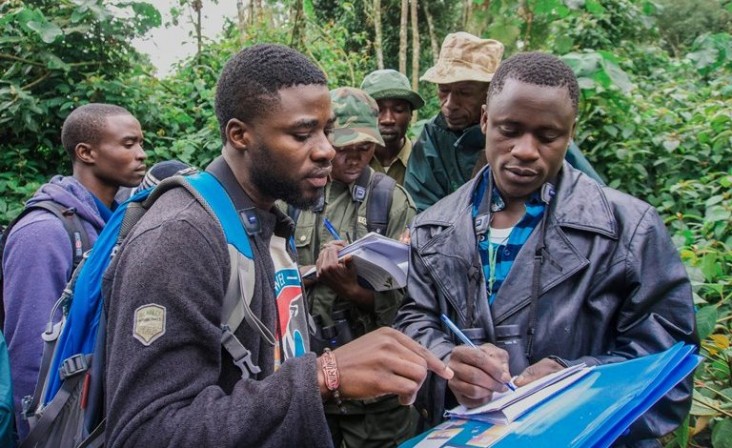Speeches Shim

Biodiversity Conservation
The rainforests of the Congo Basin are the world’s second largest block of tropical forest. They provide critical climate and ecosystem services and harbor an exceptional abundance of endemic, threatened and globally significant biodiversity, including the principal remaining populations of African forest elephants, gorillas and rare species such as Okapis (a forest-dwelling giraffe relative) and bonobos (a distinct great ape species found only in the DRC). The Congo River that flows through the basin is the second largest river in the World after the amazonie basin.
Biodiversity loss due to habitat destruction, unsustainable bushmeat trade and illegal exports of wildlife products such as ivory are the most significant threats in the region. The governments of the Congo Basin countries above mentioned have recognized the growing threat to their forests, and have indicated a desire to act; they need to strike a balance between managing the resources to meet current local and global needs and conserving the resource base for future generations.
To protect wildlife habitats and mitigate threats to endangered species and biodiversity in general, USAID provides technical assistance and training to national and local authorities and communities to better manage and conserve wildlife in 32 million hectares of critical areas in nine carbon rich and biologically diverse natural forest landscapes in the DRC and RoC with parts of landscapes in Central African Republic and Rwanda. This include support to improve protected areas management using appropriate technology and tools, performing surveys to understand the dynamism of wildlife population, building capacity for land use planning and community forestry, communication and outreach, establishing intelligence networks and systems and sustainable alternative income and livelihoods activities.
At the regional level, USAID improves national and regional environmental policy and regulatory capabilities for sustainable forest and biodiversity conservation management, and improves monitoring, analysis, and dissemination of information about forest cover change, forest-based greenhouse gas emissions and carbon sequestration, and biodiversity to help maintain the ecological integrity of the humid forest ecosystem of the Congo Basin.
Combating Wildlife Trafficking
Poaching of high-value endangered species for trade is threatening the survival of keystone species such as forest elephants and apes in Central Africa. According to a report released by the Convention on International Trade in Endangered Species of Wild Fauna and Flora (CITES), more than 20,000 African elephants were poached across Africa in 2013.
Recognizing this as a threat to United States national security, the United States Government established the National Strategy for Combating Wildlife Trafficking (CWT) in 2013. Since FY 2014, USAID has re-aligned CARPE, its major conservation program, to more effectively and comprehensively combat wildlife trafficking.
USAID’s CWT priorities for CARPE are: i) improving the capacity of park rangers and eco-guards to increase and conduct effective and efficient patrols to combat wildlife poaching; ii) strengthening the capacity of relevant authorities to develop and implement strategies and action plans and effectively enforce national laws and international regulations to combat poaching and trafficking of wildlife and wildlife products; iii) supporting the establishment of intelligence systems within local communities and sharing of information to detect movement of illegally harvested/collected wildlife species and products at the regional and national levels; and iv) reducing bushmeat consumption and its commercial trade. USAID’s CWT interventions are closely coordinated with the United States Fish and Wildlife Service to ensure a shared approach to fighting wildlife threats and to promote transboundary cooperation to disrupt trade routes for illegal wildlife products.
Global Climate Change Mitigation
The Congo Basin forest range from dense tropical forests and woodland savannas, to swamp forests. Many of the forest landscapes lack effective infrastructure and management. They are also under increasing threat from growing population and the demands of international markets for forest-related commercial products.
According to the recently completed CARPE III Mid-Term Evaluation, the primary drivers of deforestation and/or forest degradation in the Central Africa region are shifting agriculture, illegal logging and artisanal mining, wildfires, charcoal production are the most critical threats to forest degradation.
USAID interventions mitigating climate change aim at reducing greenhouse gas emissions and increasing carbon sequestration while achieving sustainable economic development through activities that promote low emission development and sustainable forest/natural resources management. This include the support of legislative and policy reforms, and to Reducing Emissions from Deforestation and Forest Degradation (REDD+) national strategies; development and utilization of forest monitoring systems to provide comprehensive information for policy decision-making; capacity building in land use planning, improve the understanding of the forest dynamics through studies and tools, and the support to promote sustainable agricultural practices, especially improved farming techniques and agroforestry plantations.

Comment
Make a general inquiry or suggest an improvement.